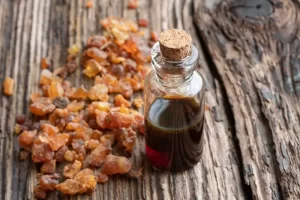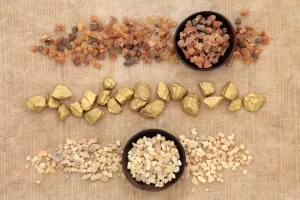Regenerate and Revitalize Skin: Homemade Frankincense and Myrrh Lotion
The skincare industry is a vast and varied world with myriad products that promise to deliver miracles. But how many of them come with ingredients that are potentially harmful? Most consumers have become more discerning about their skincare products, especially with reports highlighting the presence of certain chemicals in many off-the-shelf options. In the wake of this awareness, homemade solutions have become increasingly popular for their perceived safety and effectiveness.
The Concerns with Store-bought Lotions
When it comes to store-bought lotions, it’s essential to know that they aren’t all created equal. While some products genuinely prioritize natural and safe ingredients, others may contain elements that raise health concerns.
Understanding what goes into our skincare products is essential to make informed decisions. While certain chemicals and compounds may have been included for their specific benefits, some have been flagged as potential health hazards.
Phthalates (as “fragrance” or “perfume”):
Description: These are used to prolong the scent of perfumes in products.
Concerns: Phthalates are endocrine disruptors and have been linked to increased risk of breast cancer, early breast development in girls, and reproductive birth defects in males and females.
Reference: The Environmental Working Group’s Skin Deep Cosmetics Database provides detailed information on the potential risks associated with phthalates.
Benzyl alcohol:
Description: This serves as a preservative and solvent in many skincare products.
Concerns: Overexposure can cause skin irritation. While the direct link between benzyl alcohol and cancer remains inconclusive, it’s always best to err on the side of caution.
Reference: Further details can be found on the Skin Deep Database.
PEG-100 stearate:
Description: This is used as a moisturizer to treat dry, rough, scaly skin and minor skin irritations.
Concerns: It can be contaminated with toxic impurities which are harmful and potentially carcinogenic.
Reference: The Skin Deep Database offers insights into various products containing this ingredient.
Parabens (Methylparaben, Ethylparaben, Propylparaben, Butylparaben, Isobutylparaben):
Description: Parabens are synthetic compounds used as preservatives in a wide range of beauty and personal care products.
Concerns: Parabens can mimic estrogen in the body, potentially leading to hormone imbalance. Some studies have detected parabens in breast cancer tissues, sparking concerns about their role in breast cancer.
Reference: Information on various parabens and their associated risks is detailed on the Skin Deep Database.
Formaldehyde-releasing preservatives (Quaternium-15, DMDM hydantoin, Imidazolidinyl urea, Diazolidinyl urea):
Description: These chemicals release small amounts of formaldehyde over time, which acts as a preservative for the product.
Concerns: Formaldehyde is a known carcinogen and can also cause skin irritations and allergic reactions.
Reference: The Skin Deep Database provides more details on formaldehyde and its releasers.
Retinyl palmitate or Retinol (Vitamin A):
Description: Often found in anti-aging products.
Concerns: When applied to the skin and exposed to sunlight, it might increase the skin’s sensitivity to UV rays, potentially enhancing the risk of skin cancer.
Reference: Further insights into the use of retinol in skincare can be found at the Skin Deep Database.
While many store-bought lotions promise miraculous skin transformations, understanding the potential risks associated with their ingredients is crucial. Making an informed choice can not only benefit your skin in the short term but also your overall health in the long run.
Natural Alternatives: Myrrh and Frankincense Essential Oils
Turning to natural solutions, essential oils have been used for centuries for their therapeutic properties. Among them, myrrh and frankincense stand out for their skin-enhancing benefits.
Benefits of Myrrh Essential Oil:
Myrrh is renowned for its medicinal properties. It is:
Anti-infectious
Anti-inflammatory
Antiseptic
Anti-tumor
Astringent and tonic
These properties render myrrh beneficial in addressing pain, inflammation, and even promoting wound healing.
Benefits of Frankincense Essential Oil:
Often revered as the “King of Oils,” frankincense boasts impressive skin benefits. It:
Facilitates cell and skin regeneration
Moisturizes dry skin
Reduces signs of aging
Minimizes the appearance of scars and stretch marks
Homemade Lotion Recipe: Harnessing the Power of Frankincense and Myrrh
Why not craft a lotion that incorporates the best of both these oils? Here’s a simple recipe:
Ingredients:
1/4 cup olive oil
1/4 cup coconut oil
1/4 cup beeswax
1/4 cup shea butter
2 tbsp Vitamin E
12 drops frankincense essential oil
12 drops myrrh essential oil
BPA-free lotion dispenser bottle
Directions:
In a bowl, combine coconut oil, olive oil, beeswax, and shea butter. Place this bowl in a saucepan filled with water.
Heat the saucepan on medium, allowing the ingredients to meld together.
Once blended, transfer the mixture to the refrigerator. Let it solidify for about an hour.
Using a mixer, whip the chilled blend until it achieves a creamy texture.
Incorporate the essential oils and Vitamin E, ensuring an even mixture.
Transfer your homemade lotion into a BPA-free bottle, storing it in a cool location.
Supplementary Information:
While this lotion is made from natural ingredients, it’s essential to patch-test any new product before full-scale use to ensure no allergic reactions. Also, while homemade remedies have their benefits, it’s essential to consult with dermatologists or healthcare professionals for severe skin concerns.
Taking control of what we apply to our skin can be empowering. While not all store-bought lotions are harmful, being aware of potential ingredients of concern is crucial. By turning to homemade solutions like frankincense and myrrh lotion, we not only harness nature’s benefits but also have peace of mind about what we’re using. Remember, it’s not just about looking good, but also feeling good about the choices we make for our skin’s health.













